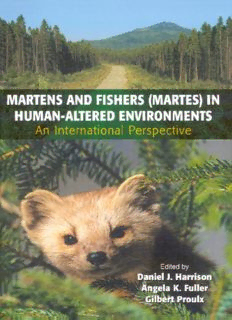
Martens and Fishers (Martes) in Human-Altered Environments: An International Perspective PDF
Preview Martens and Fishers (Martes) in Human-Altered Environments: An International Perspective
MARTENS AND FISHERS (MARTES) IN HUMAN-ALTERED ENVIRONMENTS: An International Perspective Springer An American marten pursuing its most common prey, the red-backed vole. Drawing by Mark McCollough. MARTENS AND FISHERS (MARTES) IN HUMAN-ALTERED ENVIRONMENTS: An International Perspective edited by Daniel J. Harrison Department of Wildlife Ecology The University of Maine Orono, Maine, USA Angela K. Fuller Department of Wildlife Ecology The University of Maine Orono, Maine, USA Gilbert Proulx Alpha Wildlife Research & Management Ltd. Sherwood Park, Alberta, Canada eBook ISBN: 0-387-22691-5 Print ISBN: 0-387-22580-3 ©2005 Springer Science + Business Media, Inc. Print ©2004 Kluwer Academic Publishers Dordrecht All rights reserved No part of this eBook maybe reproducedor transmitted inanyform or byanymeans,electronic, mechanical, recording, or otherwise, without written consent from the Publisher Created in the United States of America Visit Springer's eBookstore at: http://ebooks.kluweronline.com and the Springer Global Website Online at: http://www.springeronline.com This book is dedicated to John “Jack” McPhee 1937–2003 Long-Time Telemetry Pilot, Naturalist, and Friend This page intentionally left blank Contents Contributors xv Preface xix Acknowledgments xxiii Part I—Status, Distribution, and Life History Chapter 1—Is Mustelid Life History Different? 3 Steven Ferguson and Serge Larivière Chapter 2—World Distribution and Status of the Genus Martes in 2000 21 Gilbert Proulx, Keith Aubry, Johnny Birks, Steven Buskirk, Clément Fortin, Herbert Frost, William Krohn, Lem Mayo, Vladimir Monakhov, David Payer, Midori Saeki, Margarida Santos-Reis, Richard Weir, and William Zielinski Chapter 3—Geographical and Seasonal Variation in Food Habits and Prey Size of European Pine Martens 77 Andrzej Zalewski Chapter 4—Territoriality and Home-Range Fidelity of American Martens in Relation to Timber Harvesting and Trapping 99 David Payer, Daniel Harrison, and David Phillips Chapter 5—Martes Foot-Loading and Snowfall Patterns in Eastern North America: Implications to Broad-Scale Distributions and Interactions of Mesocarnivores 115 William Krohn, Christopher Hoving, Daniel Harrison, David Phillips, and Herbert Frost Part II—Habitat Relationships Chapter 6—Home Ranges, Cognitive Maps, Habitat Models and Fitness Landscapes for Martes 135 Roger Powell viii Chapter 7—Relationships Between Stone Martens, Genets and Cork Oak Woodlands in Portugal 147 Margarida Santos-Reis, Maria João Santos, Sofia Lourenço, João Tiago Marques, Iris Pereira, and Bruno Pinto Chapter 8—Relationships Between Forest Structure and Habitat Use by American Martens in Maine, USA 173 David Payer and Daniel Harrison Chapter 9—Effect of Ambient Temperature on the Selection of Rest Structures by Fishers 187 Richard Weir, Fraser Corbould, and Alton Harestad Part III—Research and Management Approaches Chapter 10—Zoogeography, Spacing Patterns, and Dispersal in Fishers: Insights Gained from Combining Field and Genetic Data 201 Keith Aubry, Samantha Wisely, Catherine Raley, and Steven Buskirk Chapter 11—Harvest Status, Reproduction and Mortality in a Population of American Martens in Québec, Canada 221 Clément Fortin and Michel Cantin Chapter 12—Are Scat Surveys a Reliable Method for Assessing Distribution and Population Status of Pine Martens? 235 Johnny Birks, John Messenger, Tony Braithwaite, Angus Davison, Rachael Brookes, and Chris Strachan Chapter 13—Postnatal Growth And Development in Fishers 253 Herbert Frost and William Krohn Chapter 14—Field Anesthesia of American Martens Using Isoflurane 265 François Potvin, Breton, and Robert Patenaude Index 275 List of Figures 1.1. Relationship between gestation length and female body mass for mustelids and other terrestrial carnivores in North America. 9 1.2. Relationship betweensexual dimorphism and female body mass for mustelids and other terrestrial carnivores in North America. 9 1.3. Relationship between population density and female body mass for mustelids and other terrestrial carnivores in North America. 11 1.4. Relationship between male home range size and male body mass for mustelids and other terrestrial carnivores in North America. 11 1.5. Relationship betweenduration of estrus and female body mass for mustelids and other terrestrial carnivores in North America. 12 1.6. Relationship between seasonality and female body mass for mustelids and other terrestrial carnivores in North America. 12 2.1. General distribution of Martes martes throughout Europe and western Asia. 25 2.2. General distribution of Martes foina in Europe. 32 2.3. General distribution of Martes foina in Asia. 34 2.4. General distribution of Martes zibellina in Asia. 40 2.5. General distribution of Martes flavigula in Asia. 43 2.6. General distribution of Martes americana in North America. 46 2.7. General distribution of Martes pennanti in North America. 57 3.1. Locations of pine marten diet studies, in relation to the first 2 principle components that described 60% of variation in winter diets of martens and 58% of variation in summer diets of martens across 43 winter and 23 summer diet studies conducted in Europe. 85 3.2. Generalized model of latitudinal variation in relative frequency of food categories in winterdiets ofpine martens (Martes martes) in Europe, based on regressions calculated from empirical data. 86 3.3. Latitudinal variation in standardized food niche breadth calculated for 6 major groups of food. 87 3.4. Relationship between mean weight of prey in diet of pine martens across Europe in the winter and summer seasons. 89 3.5. Relationship between relative frequency of medium to larger-sized prey in diets of pine martens and meanbody mass of all prey and the condylobasal length of male marten skulls. 90 3.6. Relative frequency of occurrence of 5 groups of rodents in diets of pine martens across 4 biogeographic regions. 91 3.7. Eleven-year variations in abundances ofbank voles (Clethrionomys glareolus) and yellow-neck mice (Apodemusflavicollis) during autumn and their percent occurrence in autumn-winter diet of pine martens in National Park, Poland. 92 5.1. Foot-loading and hind limb length for large and medium-sized carnivores that historically occurred in eastern North America. 124
Description: